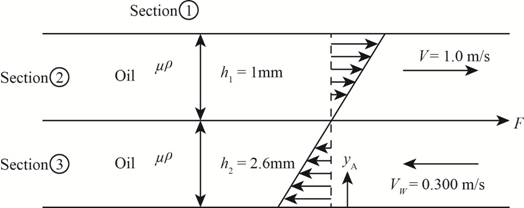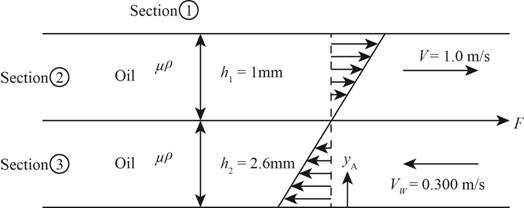
Concept explainers
Oil of viscosity
The top plate is stationary, but the bottom plate is moving at velocity

(a)
Velocity profiles between the plates and the distance where velocity is zero.
Answer to Problem 132P
The below figure shows the velocity profile.

The velocity is zero from bottom at the height of
Explanation of Solution
Given information:
Dynamic viscosity is
The velocities will be zero at the boundaries of the plate due to no slip condition.
Write the expression for the velocity.
Here, the pressure gradient is
Calculation:
Substitute
The below figure shows the velocity profile.

Figure-(1)
Conclusion:
The velocity is zero from bottom at the height of
(b)
The force required for moving the middle plate at constant speed.
Answer to Problem 132P
The force required for moving the middle plate at constant speed is
Explanation of Solution
Write the expression for the force required.
Here, shear stress is
Write the expression for the shear stress.
Here, shear stress is
Substitute
Write the expression for the force required between first and second plate.
Here, velocity gradient between plate one and two is
Write the expression for the force required between the second and third plate.
Here, velocity gradient between plate two and three is
Write the expression for the total force.
Here, total force is
Write the expression for velocity gradient between plate one and two.
Here, steady velocity of plate two is
Write the expression for velocity gradient between plate two and three.
Here, steady velocity of plate two is
Substitute
Calculation:
Substitute
Conclusion:
The force required for moving the middle plate at constant speed is
Want to see more full solutions like this?
Chapter 2 Solutions
Fluid Mechanics: Fundamentals and Applications
- Crude oil having a viscosity of 9.52 x 10(-4) lb-s/ft2 is contained between parallel plates. The bottom plate is fixed and upper plate moves when a forced P (lb) is applied. If the distance between the two plates is 0.1 in., what value of P is required to translate the plate with a velocity of 3 ft/s? The effective area of the upper plate is 200 in2.arrow_forwardSpaces h1=15 mm and h2=20 mm wide between upper and lower stationary plates and a very thin moving plate is filled with crude oil (oil =7.18x10-3 Pas) and water (water =1.00x10-3 Pas), respectively. What force is required to drag the plate of 0.5 m2 area between the surfaces at a speed of v=0.15 m/s. Assume linear velocity profilearrow_forwardA space 22 mm wide between two large plane surfaces is filled with honey with absolute viscosity 0.16 N.s/m2 . What force is required to drag a very thin plate of 0.6 m2 area between the surfaces at a speed, v = 0.22 m/s(i) if this plate, t is equally spaced between the two surfaces? (ii) if t = 3 mm?arrow_forward
- Determine the values of A and B such that the primary boundary conditions for the velocity profile are satisfied. Is it necessary to apply any auxiliary boundary conditions?arrow_forwardA plate with a length of 1.5 m is placed in a wind tunnel so that the air passes over it at a speed of 7.5 m Find the Reynolds number, then find the thickness of the layer, knowing that the kinematic viscosity is 1.679 * 10 ^ - 4arrow_forwardA liquid with kinematic viscosity of 3 centi stokes and specific weight 9 kN/m3 fills the space between a large stationary plate and a parallel plate of 475 mm square, the film thickness being 1 mm. If the smaller plate is to be pulled with uniform velocity of 4 m/s, determine the force required if the liquid film is maintained all through.arrow_forward
- A fluid with a velocity of 30 m/s flows past a sphere with a radius of 40 mm. The density and viscosity of the fluid is1.32 kg/m3 and 3.6 x 10-5Pa.s, respectively. Calculate the force exerted on the sphere? (CD = 0.31)arrow_forwardDetermine the velocity profile within a 12 µm diameter capillary, with a viscosity of 4 cP, and a pressure gradient of 25 mm Hg/500 µm. Assume that gravitational effects can be ignored and that the blood vessel is perfectly cylindrical.arrow_forwardThere are two liquids in the container in the picture: oil of density ρu=820kg/m3 and water of density ρw=998 kg / m3. Calculate max. pressure in the vessel if it rotates at an angular velocity ω=10 s-1. D=0.76m, H=0.9m, h1=0.3m, h2=0.45marrow_forward
- Two horizontal plates are spaced 3 in. apart. The spacebetween the plates is filled with mercury at 90 ° F . The upper plateis moving at 3 ft /sec, (a) Why does the liquid velocity vary linearly between the plates ? (b ) Calculate the shear stress at a plane 1 in. from the slowermoving plate.(c) Calculate the momentum flux at the surface of the fastermoving plate.arrow_forwardthe space between two square flat parallel plates is filled with oil .Each side of the plate is 50 cm .The thickness of oil film is 10 mm .The upper plate, which moves at 2 m/s requires a force of 95 N to maintain this speed. Determine: a- the dynamic viscosity of oil in poise. b-the kinematic viscosity of the oil, if the specific gravity of oil is 0.9arrow_forwardA piston has a 6 "diameter where a 6.008" bore riser slides. The piston is 6 In.long and weighs 2.2 Ib. Determine the terminal velocity of the piston if it is lubricated with oil with a viscosity of 0.020 Ib-s / ft2.arrow_forward
 Elements Of ElectromagneticsMechanical EngineeringISBN:9780190698614Author:Sadiku, Matthew N. O.Publisher:Oxford University Press
Elements Of ElectromagneticsMechanical EngineeringISBN:9780190698614Author:Sadiku, Matthew N. O.Publisher:Oxford University Press Mechanics of Materials (10th Edition)Mechanical EngineeringISBN:9780134319650Author:Russell C. HibbelerPublisher:PEARSON
Mechanics of Materials (10th Edition)Mechanical EngineeringISBN:9780134319650Author:Russell C. HibbelerPublisher:PEARSON Thermodynamics: An Engineering ApproachMechanical EngineeringISBN:9781259822674Author:Yunus A. Cengel Dr., Michael A. BolesPublisher:McGraw-Hill Education
Thermodynamics: An Engineering ApproachMechanical EngineeringISBN:9781259822674Author:Yunus A. Cengel Dr., Michael A. BolesPublisher:McGraw-Hill Education Control Systems EngineeringMechanical EngineeringISBN:9781118170519Author:Norman S. NisePublisher:WILEY
Control Systems EngineeringMechanical EngineeringISBN:9781118170519Author:Norman S. NisePublisher:WILEY Mechanics of Materials (MindTap Course List)Mechanical EngineeringISBN:9781337093347Author:Barry J. Goodno, James M. GerePublisher:Cengage Learning
Mechanics of Materials (MindTap Course List)Mechanical EngineeringISBN:9781337093347Author:Barry J. Goodno, James M. GerePublisher:Cengage Learning Engineering Mechanics: StaticsMechanical EngineeringISBN:9781118807330Author:James L. Meriam, L. G. Kraige, J. N. BoltonPublisher:WILEY
Engineering Mechanics: StaticsMechanical EngineeringISBN:9781118807330Author:James L. Meriam, L. G. Kraige, J. N. BoltonPublisher:WILEY





